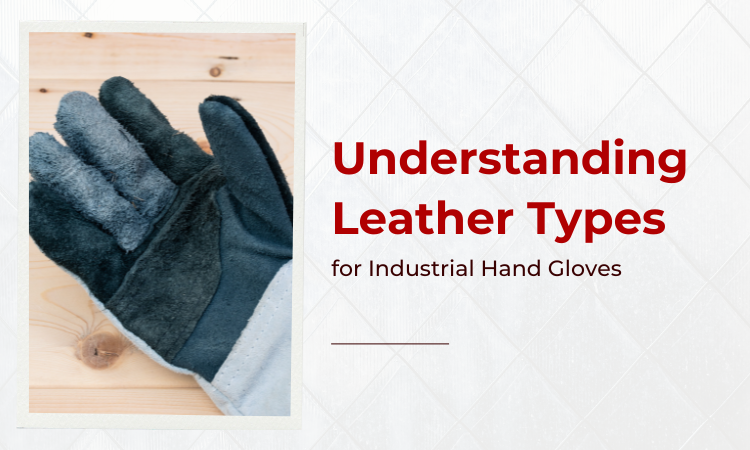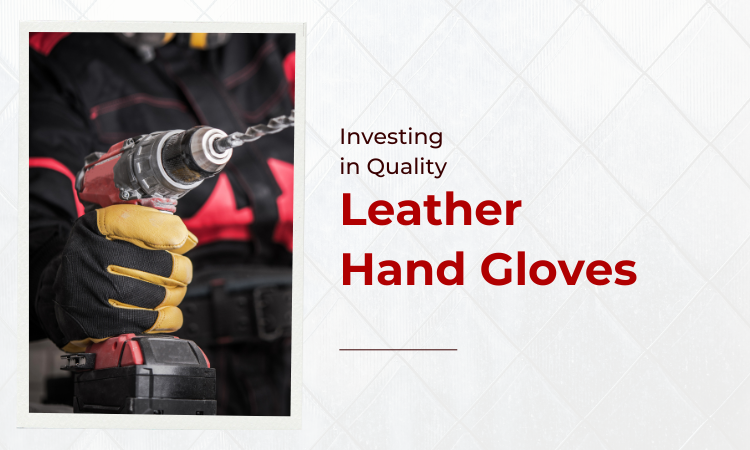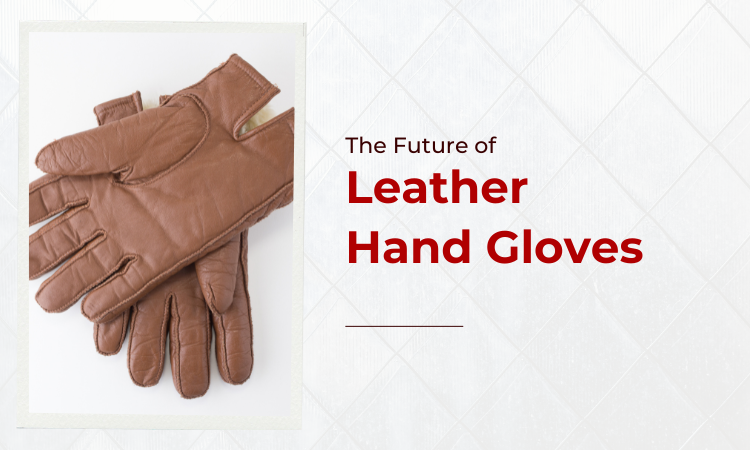Table of Contents
Introduction:
In today’s industrial landscape, protecting your workers’ hands is paramount. That’s where industrial leather hand gloves come in. For generations, leather has been the go-to material for industrial hand protection, offering a unique blend of durability, dexterity, and protection. But with so many options available, choosing the right leather hand gloves for your workplace can be overwhelming. This essential guide will equip you with the knowledge to navigate the world of industrial leather hand gloves, ensuring your workforce stays safe and productive.

Choosing the Right Leather: Understanding Leather Types for Industrial Leather Handware:
Not all leather hand gloves are of the same quality. In the industry, the kind of leather used has a great impact on the glove’s suitability for specific functions and endurance. Here’s a breakdown of key leather properties to consider:
Grain Structure: Full-grain leather utilizes the entire thickness of the hide; hence, it is a better alternative compared to other types of leather in terms of affability and puncture resistance. A high-grade leather peel of a thinner outer layer leaves it softer and even stronger than plain top grain. Another leather construction technology is split-grain leather which is cut from the remaining inner layers providing a more cost-effective alternative, with a decent level of durability against abrasion and puncture protection.
Thickness: The thicker the leather is the longer it will last and more resistant to heat, suitable for harsh uses in welding, handling of hot materials, and so on. On the contrary, this lacks dexterity. Thin Leather does have qualities like enhanced flexibility and sensitivity of fingers, very useful when it comes to the tiniest works such as component assembly or machine operation.
Finish: Unfinished leather can keep its natural breathability effect, which is very comfortable for longer wear. Similarly, it may also be prone to shrinking by absorbing the moisture in the air. Treated or finished leather offers water repellency or additional fire resistance depending on the application.
Tanning Process: The different tanning strategies have an impact on the flexibility, waterproofness, and heating tolerance of leather. Chrome-tanned leather is highly long-lasting and less prone to tears than vegetable-tanned leather.

Safety First: Essential Features to Look for in Leather Hand Gloves:
Safety with leather hand gloves for industrial purposes is not an option but a must. Here are some key features to prioritize when selecting the right gloves for your workplace:
Cut and Puncture Resistance: The level of risk determines the type of gloves – reinforced ones with palms or tips of fingers required for protection against cuts and abrasions. Kevlar® or other knife-resistant materials, which are well-known for their protective qualities, can be added to the linings. This will provide an additional degree of security.
Heat Resistance: Among those tasks requiring exposure to heat, a protective lining may be added that can be made from aluminum foil as an extra layer of guard against it. You can buy your staff the right kind of gloves with their suitable temperature ratings taking into consideration the fact that they are exposed to varying degrees of heat.
Chemical Resistance: Listed as a hazard in your workplace, choose (chemical-resistant gloves) for your workers that handle such chemicals. It’s best to make sure that the gloves you wear are appropriate for the kind of chemicals used in your workplace.
Dexterity and Grip: First of all, while prioritizing protection, dexterity should not be neglected. Select gloves that are comfortable to put on and give room for fingers for fine adjustments. First of all, configure elements such as pre-curved fingers and breathable liners so that maximum comfort is attained and precautionary measures are excellent.
Seam Construction: Give preference to gloves of tough fabric with selected reinforcement in places of a high load during an operation. Stitching methods such as Kevlar® weaving can thereby lend more durability to the work.
Compliance: Make sure you take into consideration the established safety guidelines set by organizations for instance ASTM International and EN 388 when looking for leather hand gloves. These standards define the thresholds for resistance to abrasion, cut, and tearing that is required.
Heat, Cuts, Chemicals: Matching Leather Glove Protection to Workplace Hazards:
Leather hand gloves have to resort to various measures in order to eliminate the many hazards from the industry that exist and these measures should be specifically targeting the workplace-specific hazards. Here’s a breakdown of how to match leather glove protection to common workplace hazards:
Heat Exposure: Consider an ounce of leather for a moderate heat source that is up to 250°C and opt for a thick heat resistant with an aluminum back that reflects heat radiation. While gloves are more proficient than bare handling, overly thick gloves may impair dexterity. High temperature environments (above 250 °C), should use gloves with flame-retardant ducts stitched into the lining.
Cuts and Punctures: (Personal protective equipment) consisting of gloves, shoes, and goggles that must be made of materials that are impermeable to blades, sharp edges, and punctures. Consider buying gloves with Kevlar® cut-resistant material or similar cut-resistant materials built into the hard areas of the palm and fingertips. On the other side, the glove consists of reinforced stitching all over the place increases its strength.
Chemical Hazards: The protective gloves should be first in line when you dealing with the chemicals, preferably one that is chemical-resistant. Yet, there are various chemicals that demand unique tactical approaches. The nitrile coating provides excellent performance against the likes of oils and solvents, with neoprene being the choice material for chemicals with a wider spectrum. Consultation with a professional safety officer may be required to determine whether your gloves have been matched with the chemicals involved in your workplace.

Dexterity vs. Durability: Finding the Balance in Leather Hand Glove Design:
Industrial leather hand gloves have a crucial role in conducting tasks without harm to workers but the biggest challenge is making the right ratio of dexterity and durability which may be difficult to achieve. Here’s how to navigate this trade-off:
Leather Type: Thicker leather ensures (gives) greater durability with the disadvantage of reduced movement of the fingers. Consider lighter-weight, high-grain leather for tasks that demand a good level of dexterity: assembly and machine operation, for example. Think about gloves with reinforcements, which are patched strategically on the palms, fingertips, and other points of contact for sturdiness as well as flexibility.
Design Features: Pre-curved fingers copy the real hand line. They make the ‘glove’ more comfortable to wear and it is easier to manipulate objects. Consider gloves with breathable membranes that take away moisture and therefore prevent your hands from sweating; they will keep the grip from failing.
Seam Construction: Seams are known to be vulnerable parts that with time may affect either the dexterity or durability. Choose the gloves by finding the seams that avoid the high flex surface and structured format to disentangle the stress and the risk of breaking. Enhanced seam strength can also be guaranteed by using gloves with Kevlar® threading without losing flexibility.
Combination Materials: Current industrial hand gloves combining many other materials with leather itself to achieve dual purposes is the common practice. Kevlar® lining provides cut resistance without trapping the finger making the grip strong and dexterity intact while nitrile coatings on the fingertip add up to grip strength and protection against chemical agents.
Task-Specific Selection: It is important for manufacturers to achieve the optimum combination of dexterity and durability when their products are intended for a particular purpose. When it comes to heavy-duty welding, choose very stiff leather (welding gloves) meant for heat resistance. However, if it is about light precision work like electronics assembly, go for a thin and flexible glove. Think of having a range of glove types ready so that for each task in your workplace you get what is perfect with you.
Leather Glove Care: Extending the Life of Your Industrial Hand Protection:
Industrial leather hand gloves are about more than safety compliance. They offer both the companies and workers peace of mind because a safe work environment facilitates higher productivity. This smart choice allows for thriving habitats with a longer life cycle and minimizes the costs. Here are some key practices for maintaining your industrial leather hand gloves:
Cleaning: Frequently get rid of mud bustle and sweat accumulated. Dab the soiled surfaces generously with a damp cloth and soap solution, and use a mild soap if necessary. Refrain from exposing the leather to too much water as this can dry it out. Keep the gloves away from sources of direct heat and allow them air dry fully.
Conditioning: Being natural, leather tends to lose its moisture over the period. Try to do that periodically and use a conditioner for industrial leather gloves. This renewal keeps the leather moist and soft, thereby improving comfort and grip and extending its lifespan.
Storage: When not wearing them, keep your leather hand gloves in a cool dry place, away from the heat and sunlight. Don’t keep them in a damp area or shove them together, as it can lead to the formation of molds. To start with, you may consider using breathable cotton laundry bags that protect your gloves from dust and restore normal airflow.
Inspections: Make a regular habit of checking your (leather gloves) for any signs of damage, such as rips, tears, or even excessive thinning. Deflations or damaged areas weakened the protection. Substitute used gloves immediately to ensure the safety of workers.
Training: Train your employees on how to handle the gloves and what to do after use. Tell them to take off the gloves before moisturizing the skin with hand creams and lotions as these products can slow down the process of leather dyeing. Stress the significance of not utilizing the gloves for purposes other than those for which they were designed.

The Cost of Safety: Why Investing in Quality Leather Hand Gloves Pays Off:
Safety should undoubtedly top the priority list whenever it comes to working conditions. If you compare the cost of best quality leather hand gloves at the initial phase it seems high but all the long-term benefits completely balance the expenditures. Here’s why:
Reduced Injury Costs: Work injuries to the hands are not only annoying for the employees who experience them but also worrisome for the companies that have to deal with them. Quality leather hand gloves by all means shield from cuts, punctures, abrasions, and burns, consequently, minimizing the possible injuries that require medical check-ups or lost work days are much likely to be avoided.
Increased Productivity: Apart from the superior comfort and excellent fit of leather hand gloves, workers will also have proper dexterity to finish their work since they can easily perform their tasks safely. Fumbling, and probably getting short with the gloves that are definitely not fitting properly is really slowing you down. Investment in quality, which guarantees a better fit and hold, will indirectly result in a better performance and increase of the output.
Enhanced Glove Lifespan: Nowadays these gloves are available at low prices, but they are made of inferior leather. So they are worn out soon, and this necessitates repeated replenishment. High-quality pronounced leather, along with quality care methods, allows the gloves to live longer. This makes the cost of gloves for the entire period lower and the amount of waste minimizes.
Improved Worker Morale: The productivity of workers is increased when they feel that they are in a secure and comfortable working environment and they are supplied with necessary work tools. It creates a feeling of security by ensuring them that their hands are safe, which in turn lets them concentrate on the given responsibilities with full confidence.
Compliance with Regulations: Many employers of the present day have rules regarding their employees’ hand protection with some even having requirements of wearing certain levels of hand protection. Investing in quality leather hand gloves that provide leather gloves that meet the relevant safety standards, guarantees compliance and avoids unnecessary fines or legal complications.
Beyond Leather: Exploring Alternative Glove Materials for Specific Industrial Needs:
While industrial hand gloves of leather is still a widely popular choice for those who appreciate the qualities of their durability and dexterity, it is not always a perfect choice. Here’s a glimpse into some alternative glove materials designed for specific industrial needs:
Kevlar®: This fiber is a synthetic one and provides cut-resistive performance, making it best for purposes related to glass handling or metalwork for which there is a mastery of manipulating sharp objects. Kevlar® can be also combined with other materials such as cotton or leather to offer superior cut resistance and breathability.
Nitrile: This versatile material shows outstandingly low permeability to a variety of oils, greases, and many chemicals. Nitrile-coated gloves are a solution for tasks related to oiling, chemical handling, or living in wet surroundings. They offer a great grip that may be easily interchanged and are lightweight and comfortable to wear.
Neoprene: It has better chemical resistance than the nitrile-based rubber, as well. Highly appropriate for dealing with elements like harsh chemicals, acids, and caustics. Neoprene gloves are waterproof and they often provide good protection against cold liquids as well. On the positive side, these do not have the problem of breathability as some others.
Metal Mesh: Metal mesh gloves with extra heat-resistant properties come in handy for such kind of heavy-duty jobs involving high heat and excess metal splashes. This filament is highly heat resistant and porous enough to ensure great airflow, so as to guarantee cool hands. Consequently, they have a limited capacity for precise work and are typically used in short-term applications requiring high-temperature intensity.
Cut-Resistant Textiles: Current textile innovation resulted in the creation of slash-proof fabrics that choose high durability and low weight over Kevlar® in a packed manner. These gloves are more comfortable and flexible and thus, ideal for tasks that are very complex and need lots of dexterity.
Maintaining Grip: Keeping Your Leather Hand Gloves Working Like New:
Grasp is a vital element as far as the effectiveness and safety of work with wearing industrial leather hand gloves are concerned. While dirt, grime, and the natural volatility of time can help push much towards the edge by taking away the grip as well as making tasks more difficult and more dangerous. Here are some tips to maintain optimal grip and keep your leather hand gloves working like new:
Regular Cleaning: The dirt accumulation and the greasiness of the palm would denture the function of the handgrip to a wide extent. Make sure to clean your gloves daily using a damp cloth and regular soap, spending more time and attention on heavily soiled areas. Don’t forget to air dry these fresh pairs of gloves by keeping them away from direct heat sources.
Leather Conditioning: Leather wears out with time, progressively getting stiffer and loses its good grip or tack. Once in a while, the application of a leather conditioner tailored for this type of glove is recommended. This restocking of the natural residual oils allows the leather material to regain flexibility hence making it grip effective.
Grip-Enhancing Sprays: A specialist in leather glove spray can be used for additional support to ensure your grip. This type of spray makes a temporary tacky surface, especially for situations with are extremely slippery and/or wet in which the object needs to stay still. Opt for sprays only approved for industrial leather gloves.
Proper Storage: If you want your leather hand gloves to always be in good condition for grip, there is a specific way to store them correctly. These have to be kept away from water (where they might get damp) and from being placed one next to another as this would facilitate the development of mold and the leather would decay. Cotton storage bags with breathability are an effective option since they restrict dust and also allow for ventilation.
Replacement When Necessary: In fact, regardless of how carefully you take care of them, leather gloves inevitably wear out. Remember to change them when you notice considerable wearing out of the points of the palms or a reduction of grip. The glove wearer’s safety and working efficiency can be jeopardized by faulty gloves.
Compliance Corner: Ensuring Your Leather Hand Gloves Meet Safety Regulations:
In the current day and age, a safety-oriented environment is what really counts. This rule applies to personal protective equipment (PPE) like industrial leather hand gloves. Here’s what you need to know to ensure your chosen gloves meet safety standards:
Understanding Regulations: There are several standard organizations across the globe to establish hand protection in various geographical settings. Know the regulations applicable in your workplace because these inform your code of conduct. Among the common standards, EN388 (Europe) and ASTM F2178 (North America) are the most frequently used ones.
Deciphering Glove Markings: Inspect the hand gloves you’re going to purchase to make sure it has compliance markings. Such markings indicate whether the gloves match the required standards and convey the level of performance in the various categories, which include abrasion resistance, cut resistance, and tear strength.
Consulting Safety Data Sheets (SDS): For jobs where chemicals are used, make ‘Safety Data Sheets (SDS)’ of the used chemicals your companion. The SDS will usually advise on appropriate glove materials and performance categories that should be used for safety.
Manufacturer Certifications: Select a trustworthy glove manufacturer’s warehouse whose products are on the mark of safety and have undergone regular audits for the appliance of the relevant standards. Seek out certifications like ISO 9001 which signifies the relationship between a company and its customers by demonstrating the company’s dedication to quality management systems.
Working with a Safety Professional: If you have any doubts, do not be shy to look for a safety official within your organization or business. They offer assistance in choosing hand gloves made from leather that meet regulation requirements and exercise a sufficient level of protection in your particular hazardous work environment.


The Future of Leather Gloves: Innovations in Industrial Hand Protection:
Conventional leather species have been one of the main choices for industrial hands for a long time, and the future holds great new improvements that bring about more safety and better performance. Here’s a glimpse into some innovative trends shaping the future of leather gloves:
Bio-Based Leather Alternatives: The organic nature of leather substitutes makes them more environmentally friendly by minimizing the usage of petrochemicals to achieve the properties of the leather. These “leather” substitutes are becoming more common in fashion as they are as durable and comfortable to wear and they have less environmental impact than the production of ordinary leather.
Smart Glove Technology: Imposing sensors and microchips into leather gloves facilitates surveillance of environmental factors like temperature, pressure, and chemical exposure in a real-time mode. This implies that such data can alert them of imminent hazards and hence they take charge by using alternative equipment or remaining alert at all times.
Nanotechnology Enhancements: Nanotechnology can take leather to a whole new level in enhancing leather’s properties. Nanoparticles having these specific properties can be integrated into the material to significantly increase water repellency, heat resistance, and self-cleaning behavior, thus prolonging the lifetime and utility of outmoded industrial leather gloves.
3D Printing Customization: The future might allow 3D printing to be the next level of glove production. Suppose to craft personal leather gloves with specific reinforcements and precision integration of functionalities to workers modeled on their tasks and preferences.
Focus on Comfort and Ergonomics: The upcoming future of industrial safety gloves demands not just protection but also worker’s comfort. Innovative design methods and breathable materials will ensure there is comfort and the fit does not cause strain nor does it impede dexterity.
Conclusion:
By following this guide and investing in high-quality industrial leather hand gloves, you’re making a significant investment in your workplace safety. Remember, protected hands are productive hands. With the right knowledge and commitment, you can ensure your workforce has the confidence and dexterity to tackle any task while minimizing the risk of injury. So, don’t wait – explore the world of industrial leather hand gloves and empower your team to work safely and efficiently.
